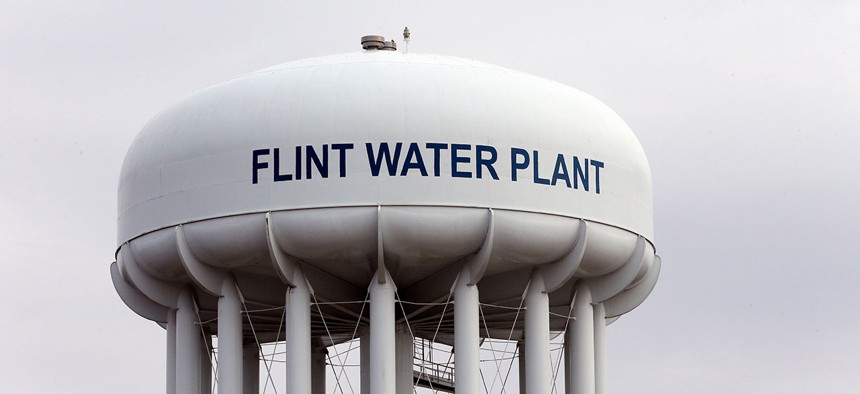Flint and the Case for Open Government
The paternalistic approach to government has run its course.
FLINT, Michigan—I can’t stop thinking about Lawrence White. In January, at a downtown coffee shop, I chatted with the 43-year-old state employee and owner of a small security firm about the poisoning of his city. Then I squeezed his thinking into one paragraph of a column on government dysfunction.
“I’m not just singling out Governor Snyder,” said the Democrat, an African American. “All the politicians including the EPA are playing tit-for-tat, playing games at our expense. It’s everybody. It’s Republicans. It’s Democrats. It’s a globalization of not caring for the people of Flint.”
His quote buttressed my theory of the case, so that’s all I shared with readers. What he said next remained in my notebook—and haunts me. White continued: “What matters to me as an American, what should matter to all Americans, is that we learn from this: How do we change the way government works? How do we fix these systems?” White paused to blow on his coffee and sip. “How do we avoid another Flint?”
I asked him if he had any ideas. White nodded.
“To start with, let me see my damn tests,” he said. “Why does the government sit on them?”
The knee-jerk answer to White’s question is that it’s the job of government to conduct public-health tests and double-check the results; to analyze the results and peer-review the analyses; to consult with internal partners and external agencies before recommending a course of action up the chain of command; to pressure-test those recommendations with political and public-relations professionals; and, finally, to inform the public: “Hey, we got a problem, and here’s what we’re going do about it.”
In the case of Flint, a tragic decision to forgo anti-corrosion treatment of the city’s aging water pipes exposed city residents to lead poisoning. State and federal tests soon revealed excessive levels of lead in the water, but the results were not shared with the public for months—and not without a push by whistleblowers atVirginia Tech University and a Flint hospital.
Flint is the worst of circumstances. But even in a best-case scenario, public-health tests take weeks, if not months, to become public.
“Let me see my damn tests.”
Maybe there’s a better way. What if governments immediately posted water test results on a website open to the public? What if citizens and citizen activists were encouraged to add their water test results to the public platform, creating a muscular database that anybody could use to spot trends and raise alarms? What if government offered prizes and other incentives to any bureaucrat, business person, citizen activist or parent who creates a solution to the present water crisis or develops a better approach, in general, to protecting Flint’s water?
The paternalistic approach to government has run its course, and not just in Flint. Averting such crises requires re-inventing government—not to be smaller or bigger, but to be more efficient and connected to a tech-empowered public, where mutual transparency and data sharing can leverage the wisdom of crowds.
Crowdsourcing government—looking to the public for innovation—is not a new idea. Napoleon offered a prize to the person who could feed his hungry army across a continent of conquered land, and the French chef who won the contest sparked the modern canning movement. But technology offers scale.
Under President Obama, more than 80 federal agencies have collaborated with more than 200,000 students, entrepreneurs, and others to tackle more than 440challenges—from developing autonomous vehicles for warfare to biomedical research serving the disabled. Napoleon’s chef won 12,000 francs. Obama’s innovators earned $150 million in prize money.
Another White House program—a start-up, actually, dubbed “18F”—leverages world-class developers, designers, and tech specialists to help agencies change how the build and buy technology services.
Governing on a social platform puts public servants under greater scrutiny. If a pothole isn’t filled or the lead levels creep up, everybody knows it. People are punished, problems solved. On the other hand, a job well done can be instantly acknowledged, rewarding bureaucrats and restoring trust in the system.
In Boston, “Citizen’s Connect” is a cell-phone application that allows users to take a photograph of a problem—say, a pothole—and send it to the city for repair. The citizen is notified when the work is done. In the Spanish town of Jun, residents use Twitter to lodge complaints with the mayor, who uses the same platform to issue orders to his staff addressing the complaints. Citizens can spot problems that governments, left to their own devices, might prefer not to acknowledge.
The role of political leaders would shift. Rather than being parental figures who withhold bad news until they can find their own solutions, 21st-century leaders would be providers of context, conveners of people and platforms, and enablers of citizens making the best possible decisions for themselves and their families.
After I laid out this theory in a series of tweets related to Flint, Republican presidential candidate Jeb Bush said he agreed. “We need accountability,” he emailed me. “Not one person is accountable. Complexity has become the means for no one to accept responsibility.”
William Eggers, author of The Solutions Revolution and an expert in government innovation at Deloitte, told me Flint points to the need for a mutually transparent government. “It’s easier to cast blame on politicians and parties than it is to set up new systems that prevent these things from happening in the first place.”
This is no panacea. Open-source governance would not only give people more power, but also more responsibility—not to overreact to every grim data set, for example, and to support new systems and institutions that set data free.
Technology can’t make government perfect. But making government more transparent and accessible might make its failures less profound.






